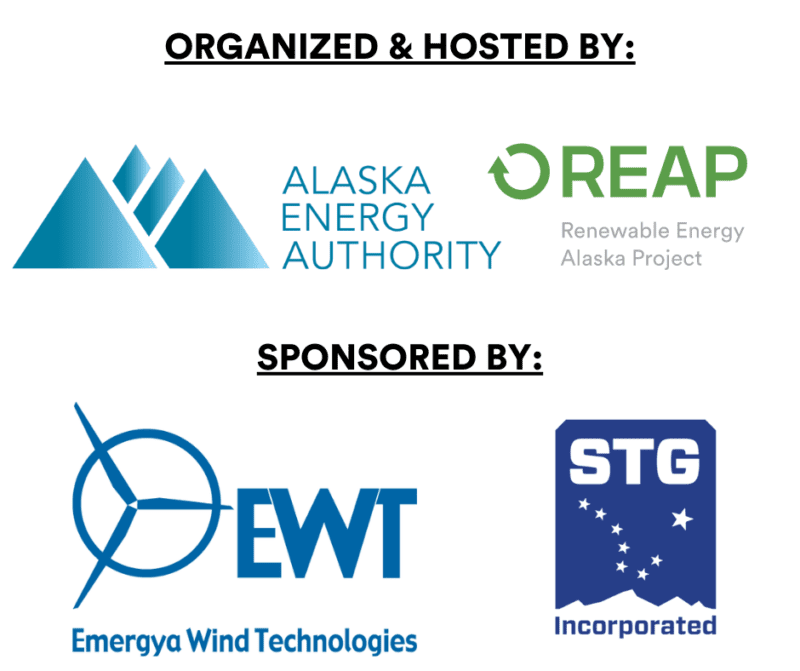
More than 120 people from across Alaska, Canada, Hawaii and the Lower 48 convened in Anchorage for the Sept. 7-8, 2023 Alaska Wind Workshop to discuss a range of issues, challenges and opportunities with developing and integrating wind power.
Attendees included researchers, utility operators and managers from the Railbelt and remote communities in Canada and Alaska, legislators, turbine manufacturers, financiers, and Independent Power Producers.
Specific focus topics included project financing, technical hurdles such as communications, and the logistics of developing, installing and maintaining wind systems in remote communities. Additionally, panelists delved into energy storage, from considerations for going diesels off to end-of-life issues for batteries including recycling and repurposing. Kodiak Electric Association CEO, Darron Scott, noted the utility’s battery purchase contract includes recycling of the batteries. Susan Babinec, stationary storage lead from Argonne National lab, also noted options for repurposing batteries and gave an overview of battery technology from the current market dominant lithium-ion to iron air and flow cell chemistries that offer opportunities for longer duration storage.
On the Railbelt, panelists looked at the current power generation mix including the looming natural gas shortage, wind integration to date, an ongoing Railbelt wind study, two proposed large-scale wind projects and a National Renewable Energy Laboratory (NREL) economic analysis of an 80% Renewable Portfolio Standard.
Looking forward, panelists discussed improvements for wind forecasting using machine learning including an Alaska specific model, potential for offshore wind-produced hydrogen in Cook Inlet, and continued expansion of beneficial electrification for heating and transportation. Noted during discussion was the fact that communities such as Kotzebue, Kodiak and Kauai that have higher rates of renewables, including wind and solar, have been able to stabilize electric rates or, in the case of Kodiak, lower energy prices over the past decade. Among the identified needs was the need for more coordination for financing and more information sharing.
The 2023 Wind Workshop is an annual event hosted by the Alaska Wind Working Group which is supported by the Alaska Energy Authority and facilitated by Renewable Energy Alaska Project (REAP). Additional sponsors for the workshop were EWT and STG Inc.
Access the conference agenda here. Below you will find the linked presentations from each of our featured speakers, organized by panel:
PANEL #1: POWERING THE FUTURE – POLICY, PROGRAMS & WORKFORCE
- Dr. Erin Whitney, Director, Arctic Energy Office
- Karen Bell, Manager of Planning, Alaska Energy Authority
- Dustin Madden, Rural Energy Program Manager, Alaska Native Tribal Health Consortium
- Chris McConnell, Director of the Alaska Network for Energy Education and Employment, REAP
PANEL #2: TECHNICAL HURDLES & OPPORTUNITIES
- Malek Tawashy, CEO, Northern Energy Capital
- Dave Messier, Infrastructure Director, Tanana Chiefs Conference
- Dave Myers, Director of Business Development, STG, Inc.
- Bill Stamm, President & CEO, Alaska Village Electric Cooperative
LUNCH PRESENTATION: RENEWABLE ENERGY IN REMOTE ARCTIC COMMUNITIES
PANEL #3: ENERGY STORAGE
- Brian Hirsch, Founder/President, DeerStone Consulting
- Jeremy VanderMeer, Research Assistant Professor, Alaska Center for Energy & Power (ACEP)
- Mihskakwan James Harper, Business Development, NRStor Inc.
- Tom Atkinson, General Manager & CEO, Kotzebue Electric Association
PANEL 4: RAILBELT WIND
- Marty Schwartz, Chief Modeler, National Renewable Energy Laboratory (NREL)
- Ed Jenkin, Chief Operations Officer, Matanuska Electric Association
- Russell Thornton, VP of G&T System Control, Chugach Electric Association
- Matt Perkins, CEO, Alaska Renewables LLC
PANEL 5: THE CRYSTAL BALL
- Tyler McCandless, Data Science Director, Tomorrow.io
- Susan Babinec, Stationary Storage Program Lead, Argonne National Lab
- Mark Glick, Chief Energy Officer, Hawaii State Energy Office (HSEO)
- David Clarke, Engineering Director, Alaska Marine Power
